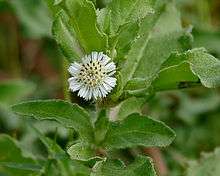Eclipta prostrata
| Eclipta prostrata | |
|---|---|
 | |
| Scientific classification | |
| Kingdom: | Plantae |
| (unranked): | Angiosperms |
| (unranked): | Eudicots |
| (unranked): | Asterids |
| Order: | Asterales |
| Family: | Asteraceae |
| Genus: | Eclipta |
| Species: | E. prostrata |
| Binomial name | |
| Eclipta prostrata (L.) L.[1] | |
| Synonyms[2] | |
|
Synonymy
| |
Eclipta prostrata commonly known as false daisy, yerba de tago, and bhringraj, is a species of plant in the sunflower family. It is widespread across much of the world.[2][3][4][5]
Other common names include kehraj (কেঁহৰাজ)in Assamese and karisalaankanni (கரிசலாங்கண்ணி) in Tamil and kayyunni (കയ്യുന്നി) in Malayalam and 'माका' in Marathi.In {Kannada} Garugada soppu, keshavardhini, Bhringaraja
This plant has cylindrical, grayish roots. The solitary flower heads are 6–8 mm (0.24–0.31 in) in diameter, with white florets. The achenes are compressed and narrowly winged.
This species grows commonly in moist places as a weed in warm temperate to tropical areas worldwide. It is widely distributed throughout India, Nepal,[6] China, Thailand, and Brazil.
Traditional uses
The plant has traditional uses in Ayurveda. It is bitter, hot, sharp, dry in taste. In India it is known as bhangra (भांग्र), bhringaraj, bhrungraja and bhringraja. Wedelia calendulacea is known by the same names, so the white-flowered E. alba is called white bhangra and the yellow-flowered W. calendulacea is called yellow bhangra.[7] The various Sanskrit names of Eclipta Alba, i.e. Bhringraj, Bhringraja, Bhrungraja etc., are literally translated as the 'King of Hair', clearly referring to its traditional reputation in Ayurveda as an herb supporting hair growth.[8] Some Ayurvedic hair oils incorporate Bhringraj as an ingredient.
It is reported to improve hair growth and color.[9][10] A study in rats showed that petroleum ether extracts of E. prostrata decreased the amount of time it took for hair to begin regrowing and to fully regrow in shaved albino rats. The result of treatment with E. prostrata was better than the positive control, 2% minoxidil.[11][12][13]
Ayurveda
In the Ayurvedic System, Eclipta Alba, as with all other herbs, is classified according to its qualities, taste, physiological effects, etc. Ayurveda states that it is: Taste – Katu (Bitter), Tikta (Pungent) Quality – Rooksha (Dry), Laghu (light to digest) Energy - Ushna (Hot) Post Digestive Effect - Pungent, i.e. undergoes a pungent taste conversion after digestion. According to Ayurveda, these qualities characterize the medicinal effects of Eclipta Alba on the body, and are expressed in Ayurvedic terms as balancing for Kapha, i.e. balancing for the moist and unctuous tissues and anabolic systems of the body such as fats and fluids, and balancing for Vata, i.e. the nervous system and catabolic functions.
Chemistry
Eclipta prostrata contains coumestans such as wedelolactone and demethylwedelolactone, polypeptides, polyacetylenes, thiophene derivatives, steroids, triterpenes and flavonoids.
References
- ↑ "Eclipta prostrata (L.) L.". The Plant List version 1.1. Retrieved 26 January 2014.
- 1 2 Flann, C (ed) 2009+ Global Compositae Checklist
- ↑ Flora of North America, Eclipta Linnaeus, Mant. Pl. 157, 286. 1771.
- ↑ Flora of China, 鳢肠 li chang Eclipta prostrata (Linnaeus) Linnaeus, Mant. Pl. 2: 286. 1771.
- ↑ Altervista Flora Italiana, Falsa margherita , false daisy, tattoo plant, Eclipta prostrata (L.) L.
- ↑ http://www.ayurvedainnepal.com/medicine/review-of-ayurvedic-medicines-herbs-and-foods/
- ↑ Puri, H. S. 2003. Rasayana: Ayurvedic Herbs for Longevity and Rejuvenation. Taylor & Francis, London. pages 80–85.
- ↑ https://americanindianimports.com/content/5_bhringraj[]
- ↑ Kritikar, KR., Basu, BD. 1975. Chronica Botanica Indian Medicinal plants. New Delhi
- ↑ Chopra, RN., Nayar, SL., Chopra, IC.,1955. Glossary of Indian Medicinal plants. C.S.I.R., New Delhi
- ↑ Roy RK, Thakur M, Dixit VK (2008). "Hair growth promoting activity of Eclipta alba in male albino rats". Archives of Dermatological Research. 300 (7): 357–64. doi:10.1007/s00403-008-0860-3. PMID 18478241.
- ↑ Datta K, Singh AT, Mukherjee A, Bhat B, Ramesh B, Burman AC (2009). "Eclipta alba extract with potential for hair growth promoting activity". Journal of Ethnopharmacology. 124 (3): 450–6. doi:10.1016/j.jep.2009.05.023. PMID 19481595.
- ↑ Roy RK, Thakur M, Dixit VK (2008). "Hair growth promoting activity of Eclipta alba in male albino rats". Archives of Dermatological Research. 300 (7): 357–64. doi:10.1007/s00403-008-0860-3. PMID 18478241.
Further reading
- Everitt, J.H.; Lonard, R.L.; Little, C.R. (2007). Weeds in South Texas and Northern Mexico. Lubbock: Texas Tech University Press. ISBN 0-89672-614-2
- Caldecott, Todd (2006). Ayurveda: The Divine Science of Life. Elsevier/Mosby. ISBN 0-7234-3410-7.
External links
| Wikimedia Commons has media related to Eclipta prostrata. |
| Wikispecies has information related to: Eclipta prostrata |
- Jepson Manual Treatment, University of California
- United States Department of Agriculture Plants Profile
